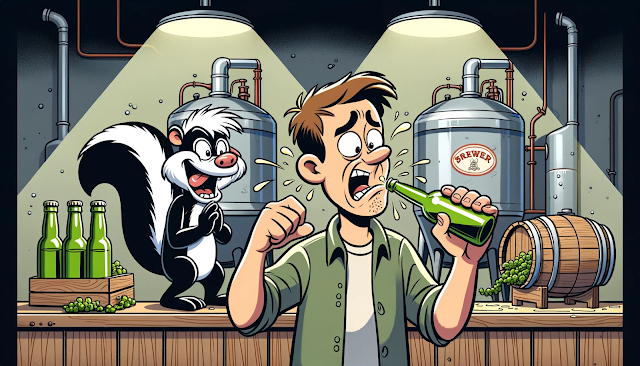The phenomenon of beer becoming skunked is a direct consequence of a photochemical reaction. When beer is exposed to light, especially ultraviolet (UV) light, it triggers a reaction in the iso-alpha acids derived from hops, which are an integral ingredient in most beers. These iso-alpha acids undergo a breakdown when exposed to light, leading to the formation of a chemical compound known as 3-methyl-2-butene-1-thiol. This particular compound has a very low sensory threshold, meaning even minute quantities can be easily detected by our olfactory senses. It is this compound that is responsible for the characteristic "skunky" odor.
The parallels between the aroma of this chemical compound and that of a skunk's natural defensive spray are not merely coincidental. In fact, 3-methyl-2-butene-1-thiol shares a structural similarity with the thiols found in a skunk's spray, leading to their comparable scents.
For brewers and beer aficionados alike, skunking is viewed as an unwanted flaw. It detracts from the intended flavor and aromatic profile of the beer, overshadowing the nuanced notes that the brewer worked meticulously to achieve. This is why the storage and packaging of beer are crucial components in preserving its intended character and preventing the onset of the skunked aroma.
Causes of Skunked Beer
Exposure to Light: The primary cause of beer becoming skunked is its exposure to ultraviolet (UV) or even certain visible lights. When the hops used in brewing beer are exposed to light, they undergo a chemical reaction that produces the compound 3-methyl-2-butene-1-thiol. This compound is very similar to the chemicals used by skunks as a defense mechanism, hence the name "skunked."
Bottle Color: The color of the beer bottle can influence the rate at which beer becomes light-struck. Green and clear bottles offer the least protection against UV light, making beers in these bottles more susceptible to skunking. Brown bottles offer more protection but are not completely immune.
Duration of Exposure: Even a brief exposure to direct sunlight or fluorescent light can be enough to skunk a beer. The longer the exposure, the more pronounced the off-flavor will be.
Preventing Skunked Beer
Store in a Dark Place: Always store beer in a dark place, away from direct sunlight or fluorescent light. If you're at an outdoor event, keep your beer in a cooler or shaded area.
Choose Brown Bottles: If possible, opt for beers packaged in brown bottles. They provide better protection against UV light compared to green or clear bottles.


